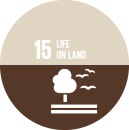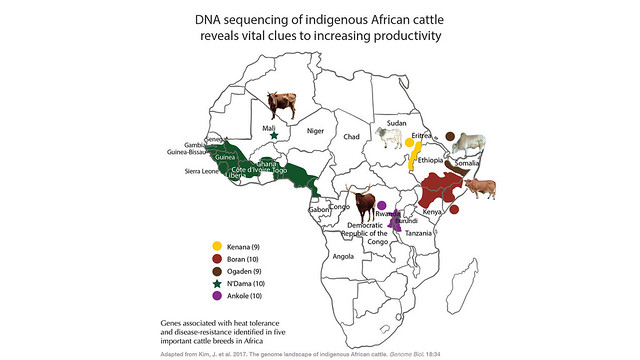DNA sequencing of indigenous African cattle reveals vital clues to increasing productivity
- From
-
Published on
19.07.18
- Impact Area
 Since their introduction to Africa thousands of years ago from the Middle East and the Indian subcontinent, cattle breeds have gradually adapted to cope with hugely varying environments, from the Sahelian desert to the subhumid tropical forests. These cattle are important sources of meat, milk, traction and manure across the continent. With rapid population growth and a rising urban middle class, they will become even more significant as demand for meat and milk is expected to more than double in sub-Saharan Africa from 2000 to 2030.
Since their introduction to Africa thousands of years ago from the Middle East and the Indian subcontinent, cattle breeds have gradually adapted to cope with hugely varying environments, from the Sahelian desert to the subhumid tropical forests. These cattle are important sources of meat, milk, traction and manure across the continent. With rapid population growth and a rising urban middle class, they will become even more significant as demand for meat and milk is expected to more than double in sub-Saharan Africa from 2000 to 2030.
Identifying the genetic basis underlying heat tolerance and resistance to killer diseases—major production constraints—offers huge opportunities to increase meat and milk productivity to meet rising demand. It opens the way to the scaling up of breeding programs for these specific key traits, potentially enhancing the incomes of hundreds of millions of smallholders worldwide.
Related news
-

ICRISAT to Deliver World-Class Services as CGIAR’s Breeding Resources South Asia Hub
International Crops Research Institute for the Semi-Arid Tropics (ICRISAT)07.07.25-
Biodiversity
-
Food security
Strategic collaboration to scale innovation and deliver harmonized, high-quality support across CGIA…
Read more -
-

Multifunctional Landscapes that reconcile food production, with ecosystem restoration and biodiversity conservation
Multifunctional Landscapes Science Program06.07.25-
Biodiversity
-
Environmental health & biodiversity
The CGIAR Multifunctional Landscapes Science Program (MFL SP) is driven by a bold vision of…
Read more -
-

Agrobiodiversity for People and Planet: How Multifunctional Landscapes Safeguard Diversity, Resilience, and Livelihoods
Multifunctional Landscapes Science Program30.05.25-
Biodiversity
-
Climate adaptation & mitigation
-
Environmental health & biodiversity
-
Food security
-
Health
-
Nutrition
Agriculture and food systems have significantly affected over 75% of Earth's land surface, polluted …
Read more -

